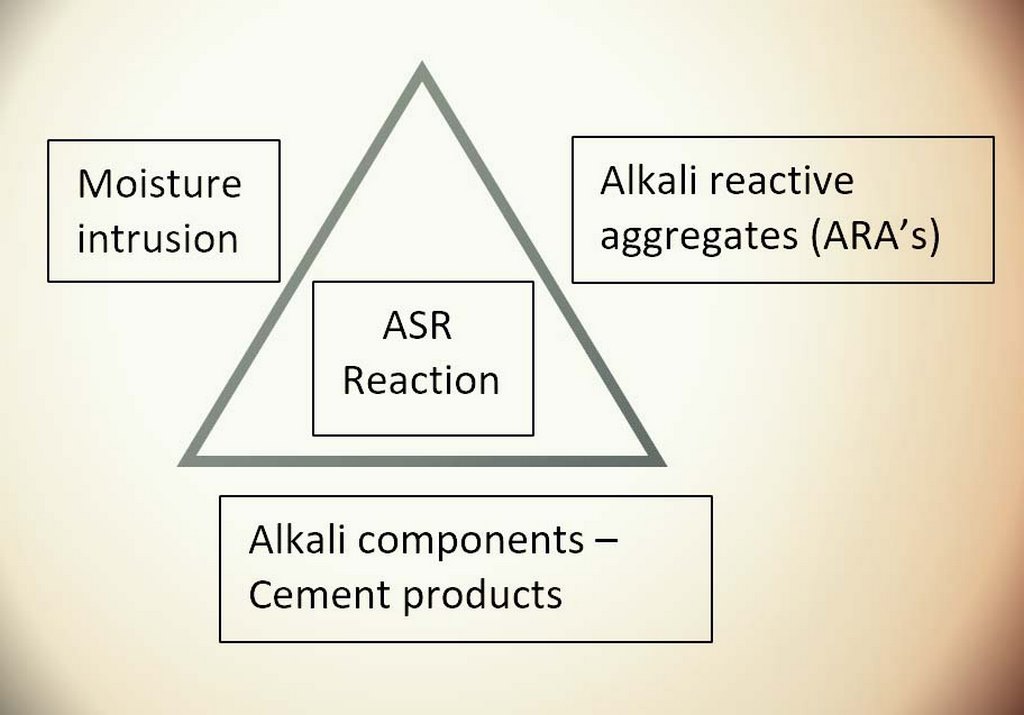Concrete Cancer III (a perfect storm)


As Paolo Benedetti explains in this conclusion to his series on Alkali Silica Reaction, although the problem can be avoided with basic and well-known precautionary measures, it is almost impossible to cure once the it starts. The business implications are grim for watershapers who are caught unaware.
By Paolo Benedetti
It’s inescapable and unforgiving logic – buckling your seatbelt after a car accident does no good. Safety measures are useless if not deployed beforehand. Unfortunately, for watershapers dealing with Alkali Silica Reaction, once it’s already happened, the same cruel reality applies. Prevention is the only “cure.”
As discussed in our two previous installments of this three-part series on “Concrete Cancer” aka, ASR, the affliction is the result of a set of reactions that occur between alkali in cement, reactive silica in aggregates, and the presence of water. Once it starts, irradicating ASR is almost impossible. It’s simply and sadly too late.
In Part II, we looked at established means of prevention, which have been used in the greater concrete industry for decades. We know that by preventing water intrusion through waterproofing, achieving adequate concrete compressive strength, using non-reactive aggregates, and including various admixtures that prevent ASR, the problem can be reliably prevented.
NOT AFTER THE FACT
The problem with ASR is that if you don’t employ those precautionary measures in the first place, there’s very little you can do about it after the fact. The result is that unwitting builders can find themselves in a financial crisis if and when their structures develop ASR.
Because of the way that the supply and distribution of materials work, especially aggregates, the problem can develop on a regional basis. In recent months, I’ve talked to builders in parts of Texas, who have been impacted and are looking for solutions. In some cases, the only remedy is bankruptcy, even though in many respects, those builders are as much a victim of circumstances as they are their own lack of awareness and prevention.
Here’s how it happened: Due to a sudden unavailability of fly ash and other pozzolans, which are used to prevent the reaction, concrete suppliers simply eliminated them from their mix designs. Though contractors saw their load tags now showed -zero- for added fly ash, no one gave it any thought.
Fast forward two years. Suddenly finished projects started experiencing a myriad of maladies. Plaster started to mysteriously delaminate, shrink cracks exploded in size and reflected through plaster, stone veneers fell off of raised bond beams, steps and benches began to develop cracking.
No one seemed to know why this is happening and a level of concern and even panic set in. Not until a few affected shells were core drilled for compression testing, was the possibility of ASR even on anyone’s radar.
The severity of the situation suddenly exploded across a region, as a multitude of projects started experiencing similar fates.
HOW BAD
Some builders have 40 affected pools. Another I know has over 100 and yet another has 80. Many more are not even aware they have problems, at least not yet. And these are just pools and does not include other concrete structures such as drilled caissons, basements, foundations, or retaining walls built by home improvement contractors.
The ultimate moral responsibility for this dilemma belongs to the aggregate and concrete suppliers. Clearly, they have the legal responsibilities to test their raw materials for initial ASTM C33 compliance, and thereafter on an annual basis.
Financially, however, these vendors may only have a few million dollars in liability insurance. Hardly sufficient resources to tear out and rebuild hundreds of pools.
That brings us to the pool builders. Most have what seems like adequate general liability coverages – $1M maximum per incident, $2M maximum policy aggregate (total claims). You can clearly see that these policy limits are also hardly adequate to cover tearing out and replacing 40 pools, let alone 100.
Settlements will quickly consume the coverages provided by the vendors, and payouts will cease when they hit their policy limits. The contractors’ policy limits may be quickly consumed by legal fees. Property owners may seek additional compensation by forcing the liquidation of company assets.
God forbid, the contractor is a sole proprietor. Their personal assets are now exposed to forfeiture to settle claims. Some may lose their homes, retirement accounts, college funds, or vehicles.
Builders have spent decades building their brands and reputations. Many builders have been brought to tears, over the potential impending financial devastation.
WHAT NOW?
Sympathy for their clients, many who have become friends, tugs at their hearts. Pride and morality drive them to do the right thing, but there just isn’t enough money to go around.
Some shrewd business owners are getting ahead of these lawsuits and potential devastating settlements by dissolving their businesses and declaring bankruptcy.
In the broader context, the industry gets a black eye from vendors who aren’t routinely testing their raw materials. The result, decades-old family run businesses are destroyed. Lives are left in financial ruin. And property owners are saddled with defective pools, who’s only repair option is to remove and replace.
Moving forward, it helps to establish your business as a legal entity (e.g. corporation or LLC) in order to protect your personal assets. Consult with a business attorney as to which is best for your situation. One mistake – setting up your entity on a DIY website — could mean disaster.
Provide written specifications to vendors, with specific wording prohibiting reactive aggregates. Before hiring any vendor or subcontractor, obtain a certificate of insurance for General Liability.

The certificate should name the pool builder as an “additionally insured” and have a “waiver of subrogation” endorsement. These are routinely used in business, and no legitimate business will object.
If there is ever a claim, you are already armed with their insurance information. You won’t have to pry it out of them or force disclosure in discovery motions.
Routinely ask for the vendors ASTM C33 aggregate assay results. They should be no older than 12 months.
If reactive aggregates are suspected or present in a region, then prophylactic measures should be taken. Fly ash, lithium and/or barium salts should be employed to prevent the occurrence of ASR.
DO IT RIGHT
Most important of all, practice sound construction principles. Use qualified structural engineering and follow the specification precisely. Do not shoot extra concrete on a floor or wall, as you may exceed the steel to concrete ratios and experience cracking. And don’t eliminate bars or reduce their size or grade.
Have your engineer review your steel installation prior to concrete. With today’s high-resolution cameras and file sharing, there’s no reason not to.
Avoid placing trimmings, rebound, sand lenses and unconsolidated materials anywhere in the structure. These all create porous cavities for water intrusion.
Run your own tests. Shoot periodic test panels. My firm shoots panels on every job. While it won’t identify ASR, it will keep the applicators on their toes.
Yes, it’s true that for many, it’s already too late and unfortunately there’s nothing anyone can do to turn back the clock and take preventive measures. The only measures that matter, both from a business and technical standpoint, remain those that happen before calamity strikes.
The time to buckle up is now.
Paolo Benedetti founded Aquatic Technology in 1993. He is an instructor for Watershape University and and has authored a myriad of articles on the finer points of pool construction and design. He is a pioneer in the field of aquatic design, constantly pushing the envelope, creating a number of firsts that spawned new trends in the industry.









